A number of you expressed an interest in seeing a “biscuit bakeoff” after last week’s Southern-Style Biscuits recipe from the back of the White Lily self-rising flour package. Does White Lily flour really make a better biscuit, as so many southern bakers claim? How do biscuits made with White Lily measure up to those made with other flours? Well, I was pretty intrigued too so I set out this weekend to find some answers.
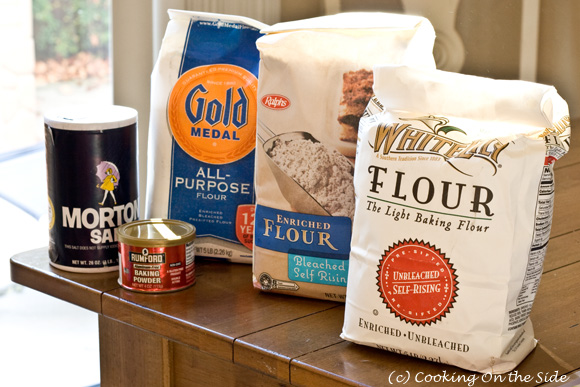
Hypothesis
Biscuit quality is impacted by the type of self-rising flour you use.
The Methodology
For a “base case” I looked to a bag of store brand self-rising flour. I would make the recipe on the back of the store-brand bag three times:
- once with the store brand self-rising flour
- once with White Lily self-rising flour, and
- once with “self-rising flour substitute” (all-purpose flour + baking powder + salt, as specified on the Gold Medal All-Purpose flour package)
Each bag of flour was purchased within the past week. As far as defining “best” goes, the consensus among my friends on Twitter, was that a great biscuit should be fluffy and light. Here’s how I chose to define those measures:
- Fluffiness = Biscuit Height; the fluffiest biscuits will be the ones that rise the most
- Lightness = Grams per Inch; the lighter the biscuit, the fewer grams per inch
While I did my best to make this test as fair as possible (I’m no statistician but I do like to dig into data), it’s hardly scientific. Still, once you see the results I think you’ll be pretty amazed!
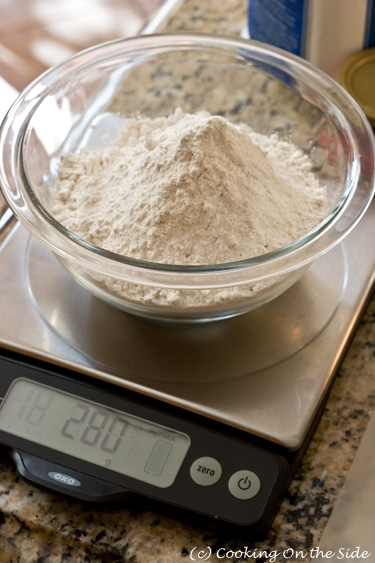
Equalizing the Flour
Since there can be a lot of variation when it comes to measuring (especially since White Lily is a lighter flour than the others), I decided to weigh the flour to ensure I used exactly the same amount in each batch. One cup of self-rising flour is equivalent to 140 grams, so I used 280 grams (2 cups) in each batch.
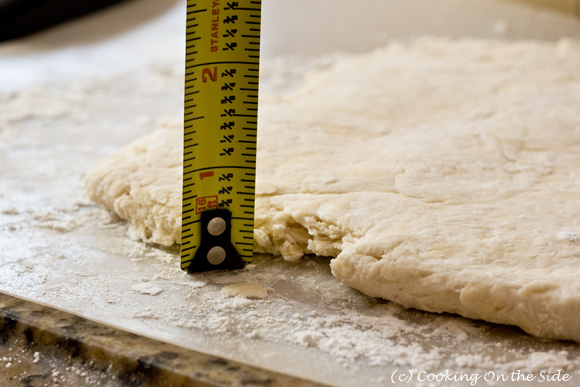
The Dough
I did my best to roll out each batch of dough to the same 1/2″ thickness. Nonetheless, I yielded a different quantity of biscuits each time (9 for the store brand, 11 for the self-rising substitute and 13 for White Lily).
Each of the doughs felt differently when I rolled them out too. The store-brand felt like typical biscuit dough I was used to, but the White Lily was notably softer and more pliable. My biscuit cutter easily slipped through the White Lily dough, barely needing any flour to keep it from sticking. The self-rising substitute dough was extremely dry and very difficult to form into a dough. The buttermilk seemed to absorb immediately.

The Biscuits
I baked a total of 33 biscuits across the three batches (it actually took the White Lily batch 5 minutes less time to bake than the other two)…
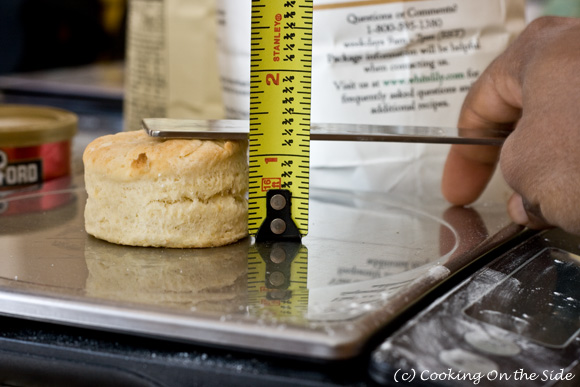
…and weighed and measured each one. As you can see from the scale, this was a rather messy operation!
Are you ready for the results??
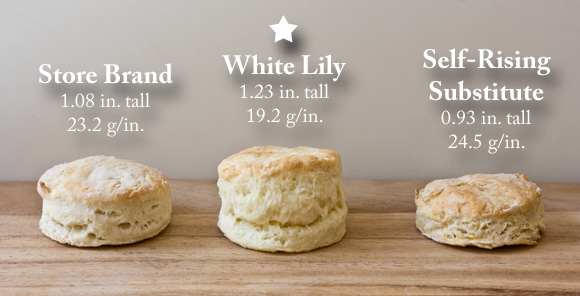
The Results
Holy cow, those southern cooks know what they’re talking about! The White Lily self-rising flour far outperformed the store brand self-rising flour and the self-rising substitute.
I knew even as I was rolling out that soft, pliable dough that the White Lily biscuits were definitely going to be different from the others. They started rising in the oven almost immediately and just kept going…13% higher on average than the store brand and 32% higher than the self-rising substitute.
The White Lily biscuits also had the lowest grams per inch, which is how I chose to define “lightness” or density. All of the biscuits in this test weighed roughly the same – about 24 grams – but when the weight is distributed over a larger area, as in the case of White Lily, it feels lighter. Conversely, the self-rising substitute yielded an absolute hockey puck. They were as dry and dense as could be and absolutely horrible. I threw those out almost immediately!
Conclusion
So I’m going to be stocking a pack of that White Lily in my pantry from now on, right?! Wow, I never would have imagined what a difference a brand of flour could make. There is some actual science behind why White Lily flour is lighter than others and, thus, better suited for items like biscuits and cakes. If only they sold the stuff in stores outside of the South and parts of the Midwest. Until they do, I’ll stick with ponying up to order it online.
I’ll keep my store brand self-rising flour as a good backup. I was actually decently happy with how those biscuits came out. If I hadn’t seen the White Lily ones I would have been perfectly content with the store brand. I probably will not, however, attempt to use a combination of all-purpose flour, baking powder and salt in place of self-rising flour. At least in this instance, it did not work very well at all.
And lastly…here’s that biscuit recipe in case you’d like to try them out yourself (with the right flour it makes fantastic biscuits!)
Buttermilk Biscuits
From the back of the Ralph’s Bleached Self Rising Flour package
Makes 8 to 10 biscuits
INGREDIENTS:
2/3 cup buttermilk
1/4 teaspoon baking soda
2 cups sifted self-rising flour*
1/3 cup vegetable shortening
DIRECTIONS:
Preheat the oven to 450°F.
Stir baking soda into buttermilk and set aside. Sift flour into medium bowl; cut in shortening until mixture resembles coarse meal. Stir in buttermilk mixture until just combined. Knead dough 3-4 times; roll to 1/2-inch thickness on lightly floured board. Cut into 2-inch rounds; place on ungreased baking sheet. Bake 12 to 14 minutes.
*If you do use White Lily, either weigh 280 grams of flour OR add an extra 4 tablespoons of flour.
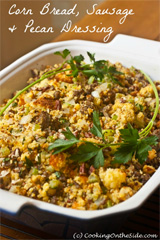

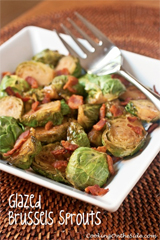
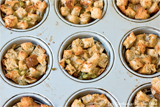
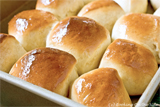
Wow! What great results! I live in KY and have easy access to White Lily flour. Sad to say though, I’ve never tried it. I guess I should’ve listened to my Grandma Evelyn who was from GA. She absolutely SWORE by White Lily flour and wouldn’t use anything else! I loved this post.
Grandma Evelyn was truly onto something!
A side by side comparison – Love this! Pictures do not lie.
What an awesome piece! I grew up on White Lily and don’t really use it now but if I want some homemade biscuits you know what I will be buying!
What an interesting experiment! Thanks for sharing!
Wow – what an experiment. Will have to keep some of the White Lily Brand flour in the pantry – clearly the substitute is not the way to go!
Who knew! I have friends coming up from Atlanta soon. I’ll definitely ask them to bring some White Lily!
Ok, WOW. First of all, if Alton Brown doesn’t have an offer letter in the mail to you right now, I’m shocked. Next, I have to admit I’m disappointed with the results – I was kind of hoping my neighborhood store brand would be just as good. (Let’s face it, I never make biscuits anyway.) I’m not sure if this is a crazy question, what is the consensus on Biquick brand biscuits?
You know, I haven’t really been a fan of Bisquick for a while because 1) I view it as a mix and I prefer to bake from scratch and 2) the hydrogenated oils. BUT after this bake-off, and my use of a crazy amount of butter-flavored Crisco therein, I should probably not turn my nose up at it. Incidentally, there will be no Bisquick present when you guys come over for pancakes in a few weeks. 🙂
Wow, this is great – I will try making biscuits again. The ones I made turned out like your #3. I do live in the south and have access to the White Lily flour. Have you made cookies or cakes with the White Lily flour?
I’m envious of your access, Vicki! 🙂 I haven’t made anything besides biscuits and pizza crust (with the White Lily bread flour) yet but I’m eager to branch out into cakes. I’m prepared to be impressed!
I had never heard of that type of flour before. I suppose it’s because I live in the north. I love your bake off. It reminds me of a science fair project in a very good way.
Thanks, Janna. I actually did do a science fair project kind of like this in 7th grade, involving muffins. 🙂
i am very intrigued by your experiment. i love to make scones, buttermilk ones, maple oatmeal ones etc… so i am wondering if lily flour would work as well? will this flour work with other baked goods such as cookies, muffins etc?
Hi Jocelyn – I’m definitely looking forward to trying their all-purpose flour in cookies. If I can find a muffin recipe that calls for self-rising flour I’d love to try it!
White Lily is very much like cake flour. It is a soft winter wheat – that is where the rise comes from. You can’t sub it one for one with all purpose, so it may not work in other recipes that call for standard flour. Your results will be much softer and lighter, which is not always a good thing.
White Lily says to add 2 tablespoons per cup of their flour to equate 1 cup of other flours, or if you go by weight (like I did in this test) it should match up. I never would have guessed there was so much variation among flours of the same type!
Swan’s Down brand cake flour also suggests that additional amount per cup. It is just soft-wheat flour, not self-rising. Maybe cake flour with baking powder would rival the White Lily for biscuits.
I loved your post, very interesting! I bake a lot, mostly sourdough bread and I can definitely tell a difference between certain flours. Thank you for sharing your experiment and recipe.
I’ve read that King Arthur flour is especially good for bread-baking. Perhaps there’s another experiment there!
There is definitely another experiment right there! 🙂 Bread flours are so different but then again there are so many other variableto consider when you work with wild yeast. I would love to see your take on it. I love your blog.
I swear by White Lily when it comes to biscuits. As you’ve seen, it really does make a difference. Now I just have to wait for my mother-in-law to bring me more…
I loved this comparison! I will be trying the White Lily soon!
That’s amazing! Thank you so much for sharing. White Lily it is!
Wow. Just wow. Fantastic Post.
Who knew the brands could make such a difference?
Thanks for sharing!
Kathy, before you give up on the “self-rising flour substitute” method, you might try what baking maven Dorie Greenspan recommends: a mixture of 1 3/4 cups all-purpose flour and 1/3 cup cake flour whisked together with the other dry ingredients. She readily admits the biscuits aren’t as stellar as those made with White Lily, but for those of us without ready access to the brand (I’m in California) I’ve found that her recipe yields consistently light, tender results.
I’d certainly trust a recommendation from Dorie. Very good to know – thanks for the tip!
Wow – thanks so much for sharing this! What a fun food science experiment;)
you might want to test King Arthur unbleached against White Lily- breadmakers like it as it has a lot of protein and can give quality biscuits as well!
I’ve read that King Arthur is best for bread and White Lily is best for lighter things like biscuits and cakes. I’ve got bread flour from King Arthur and White Lily on hand…sounds like I may need to put those two to the test on some bread!
What a great post! Thanks for going thru so much trouble & effort- I will definitely be getting a bag of White Lily flour!
This is awesome! Way to go for being the super tester!! I had just made some buttermilk biscuits and they kinda flopped! I just found out that my local grocery store carries White Lily! I’ll be stopping to nab some tomorrow!! Thanks!!
In “Biscuit Bliss,” author James Villas, a North Carolinian, suggests to us Northerners that KAF’s Mellow Pastry Blend is an acceptable sub for White Lily. The wheat isn’t quite as soft nor the protein content as low, but he says it makes very good biscuits. And here’s his formula for homemade self-rising flour, which is very similar to Dorie Greenspan’s and should yield about a dozen biscuits: 1 1/4 cups all-purpose flour, 3/4 cup cake flour, 4 t. baking powder and 1 t. salt.
super fun experiment! nope, that many home cooks can’t be wrong. 🙂
Who knew??? I always bypassed the White Lily flour in our Kentucky grocery stores because it costs a little more; now I’ll pick some up! (I’m coming to San Diego for a weekend in a couple of weeks if you’d like me to bring some of the White Lily brand out!) 🙂
Definitely send me an email with your plans, Mindy – it would be so great to finally meet you! No need to lug a 5 lb bag of flour out here, I know how challenging it is to comply with those luggage weight limits when travelling with a family. 🙂 Thanks so much for thinking of me, though!
Great post! I will have to search out the White Lily flour, as I also live in an area that doesn’t stock it. Appears to be well worth the effort, though.
Wow! I honestly didn’t think there was going to be that big of a difference between the flours. Looks like I need to pick some White Lily flour :).
I had fun reading this — lots of work! Great to know, though. Haven’t used self-rising flour in more than 10 years, so good to know I’m not missing anything in the biscuit dept. 😉
Great post Kathy. Just made some great biscuits the other night, never realized that the type of flour I used could really result in such a diffrent biscuit. Im gonna make sure to look out for this white lily flour, Im really not to sure of the availabilty here in New York.
I’ve used White Lily all my life and it really does make a difference in your baked goods. The company actually changed hands a few years back and the “recipe” for the flour changed very slightly. Used to be even better, but it’s still good. I’m never without it in my pantry.
Love that you tested all these flours – the results are all so different & the winner is very obvious 🙂
Just curious why no one except Smuckers is offering to ship WL flour, and even at that, they require you buy an unrelated mix as part of a package deal. What about we Northerners? Can’t we have beautiful biscuits too!?
Any sources for online purchase?
It’s because White Lily is owned by Smucker’s. I didn’t have to buy any kind of unrelated mix…you just have to order two bags of flour. I chose the self-rising and the bread flour this time around. Next time I’ll go for the regular all-purpose.
Interesting results! Did you consider the age of the baking powder used in the DIY self-rising flour mix? That can have an effect.
Yes, I purchased all of the ingredients within the previous week to try to mitigate age factors.
maybe the home made substitute needed a few whirles in the food processor to blend and fluff it up? The fact that you said WL flour only needs 2 TBs (1/4 c) for each c of regular flour makes that seem backwards though. Ugh, I’m confused! Anyway, I still think a whirl in the food processor can’t hurt.
I use White Lily flour for everything except yeast breads. It works great and I love it! It is definately the best for biscuits. I had no idea it isn’t available everywhere though (I’m in GA). Thanks for the fun experiment!
So happy to have discovered your blog! I loved reading this and seeing your results. Now to get my hands on some White Lily flour! Thanks for the resource info.
Excellent! I love your careful approach. Thank you for taking the time to do the experiment and carefully writing it up.
This is great information!! Thanks. I will try this as soon as I can. I have a question however. You put the baking soda into the buttermilk before you mix it in the flour. The baking soda reacts with acid (the buttermilk) to produce carbon dioxide gas which causes the baked good to rise. It seems adding it to the buttermilk instead of the flour would cause the gas to be released too soon and escape into the air instead of causing the bisquit to rise. But this apparently doesn’t happen as your bisquits look fantastic. Any reason why it works this way and why this is different from most bisquit recipies?
You bring up a very interesting question, I wish I knew the answer. I guess it would be worth a try to bake them both ways – adding the baking soda to the buttermilk and adding it to the flour. The only thing I can think of as to why the biscuits still rise well is that the buttermilk-baking soda mixture is being added to *self-rising* flour, which contains baking powder.
White Lily makes the best pancakes, too. The only acceptable substitute is Martha White, and it’s not quite the same.
Tip for those who can’t get hold of White Lily – you can mix regular all-purpose flour and cake flour 1:1 to get a lighter result without the softer southern flour. To make it self-rising, add 1 1/4 teaspoons of baking powder and 1/4 teaspoon of salt per cup. It won’t be exactly the same, but it will be better than the regular flour.
Just wondering…how did your w l biscuits taste? Also I wanted to add that w l is available at Miejer stores and other groceries in OH, MI,IN, IL as well as the usual southern states.
I like W L but sometimes I find the baking powder taste a little strong. And I usually try to use unsalted butter to balance out the flavor.
Very interesting and useful information. Thank you!
Well, it’s been about 18 months since I did the test but I’m sure I must have thought they were good back then! 🙂 As I mentioned, they came out fluffy and light, which to me is a good thing.
wow they look great – I’m going to look for the white lily flour for sure! I’m in the south so hope I can find it. I’ve just always used whatever and never thought about it. Thanks for doing all the work for us.
Thank you very much for this! My grandmother made cathead biscuits …in cast iron skillets in a wood stove. Kinda ages me, doesn’t it? Well, she taught my mom how to make them when mom and dad moved north. My mom tried to teach me, but she never measured so it (I, actually) was a lost cause; it was a lost art.
I’ve tried recipe after recipe and searched all over to figure out how to make fluffy, and white-in-the-middle biscuits. These look like they’re it! Okay, maybe not cathead shaped, but the color and webbing (?) on the side look exactly right!
I found a place on line to order White Lily, so I’m doing it!
I will write back with the cathead biscuit results. Thank you very much!!
I hope everything works out well, Tina!
Hey stranger! I just found this post while searching for pizza doughs. I know I’m over a year late to comment, but I’m so glad you discovered the wonder that is White Lily. When I lived in Los Angeles, I used to order it snail mail because any other flour just wouldn’t do. What can I say, Southerners know their flour 😉
Hope your well! Best, Nealey
Hi Nealey!! Yeah, it’s definitely worth paying a premium for. I recently found it at a restaurant supply store up in LA – it was almost $7 a bag – still a steal! 🙂
Which one in LA? I am frantically looking for WL!
I found it at Surfas in Culver City
Self-rising flour is actually just regular flour with a little salt and leavening agent (baking powder) mixed in. Thus, in order to truly compare the Gold Medal AP Flour to the other two, you’d actually have to add about a 1tsp of baking powder and maybe 1/4 or 1/2tsp salt.
Another point to make is that the lighter White Lily is really a cake flour, with lower protein content than all-purpose or bread flour. If you can find an off-the-shelf cake flour, it might be interesting to add a little baking powder and see how they turn out. If it is comparable it might save people some trouble and expense trying to get the White Lily stuff.
Oh duh, I misread and thought you used the AP with a standard recipe, but you already accounted for the self-rising action. Sorry!
I still wonder about using cake flour, though!
When I called to ask for a substitute they (White Lily) told me Pillsbury’s SoftasSilk is a close substitute but not quite …
My aunt only uses White Lily, and she makes the best biscuits you’ll ever taste. They are always light and fluffy.
I have a recipe that calls for “All purpose soft-wheat flour, such as White Lily” I have researched the internet but all I can find is “White Lily All Purpose Flour”. Is “White Lily All Purpose Flour” the same as all purpose soft-wheat as required by the recipe I am trying to use? Thank you so much for your help.
I have never, ever been able to make good biscuits but I keep trying!
Hi Edith – I’m pretty sure the White Lily all-purpose is what the recipe is calling for. They probably mentioned “soft wheat” to describe the softer type of all-purpose flour that White Lily is.
i AM LOOKING FOR FLOUR WITH BUTTER CHIPS IN IT, wHAT BRAND IS IT AND WHERE CAN i GET IT?
I’m afraid I haven’t heard of flour with butter chips in it – I usually use good old fashioned flour and butter. 🙂
I have always used White Lily flour. Since you demonstrated that White Lily was the superior flour, why would you give us a biscuit recipe from some no name flour? Just use the recipe on the back of the the White Lily flour bag since they obviously know what they are doing. As an added bonus, there is no need for the baking powder.
How can I thank you for creating this experiment? I googled, trying to find the weight in grams of White Lily Self Rising flour … my one and only biscuit flour and found your blog. In the past, I’ve gone so far as to take everything out of my freezer space so I can load it with five bags of White Lily, purchased on vacation in NC. Fortunately, Wegmans has brought White Lily to MD and I can actually store a wider range of specialty flours in my tiny freezer space. And now I know the weight in grams and I admire your determination and efforts. Thank you! How about I send, by post, a fresh bag of our favorite flour to you?
Hi Kathy Strahs,
I relocated from NJ to PA and this small down only had Giant Supermarkets in the area. I am use to Shoprite for their many varieties of groceries. Here, my favorite Aunt Jemima flour is not available in Giant. So I have to go there looking for what is safe to buy for making biscuits. I didn’t know where to turn especially when I don’t have money to waste.
Prior to visiting Giant, I decided to do a little research. I googled What is the best brand name flour to use to make biscuits? and many didn’t answer the search question the way your’s did. Your data from your research informed me of not only a good brand to use, but one not to use for biscuits. THANKYOU.
Now it is a matter of learning if Giant carries Whitelily flour. They don’t have much of a selection, but fingers crossed.
Sincerely,
Michelle
I hope you’re able to find it, Michelle! Thanks! ~Kathy
I started making my biscuits with white lily flour years ago i live in georgia so the stores here carry white lily,I have used other brands of flour at times when the flour was on sale and needed a bargain at the time but i was never happy with the results of the biscuits made with them and always went back to white lily,Now white lily cost a little more then the others(not naming any brands) it was always worth it to me and my family swears i make the best biscuits of all,,i will be 74 the 4th of april so i have been making biscuits a long time.